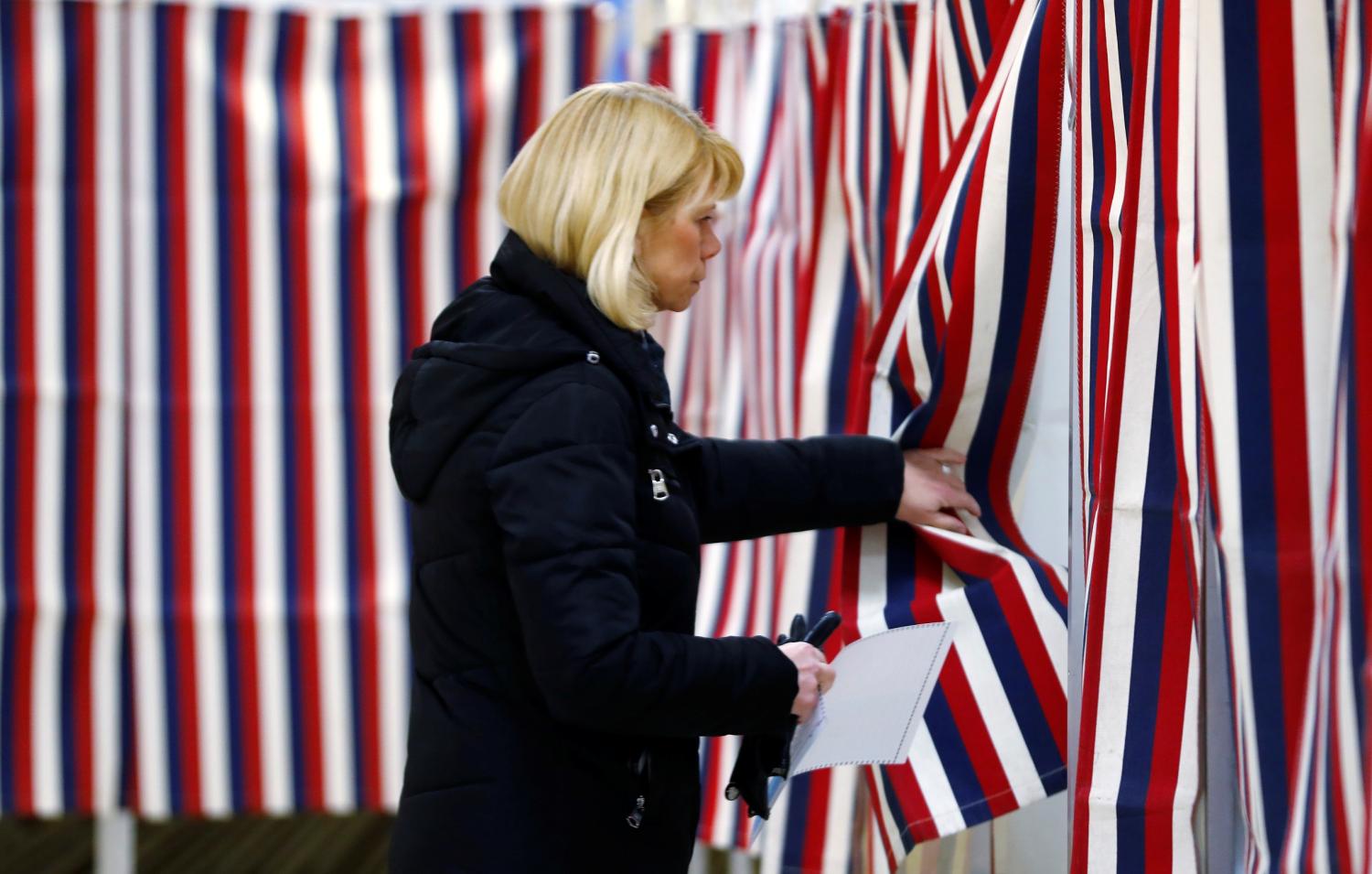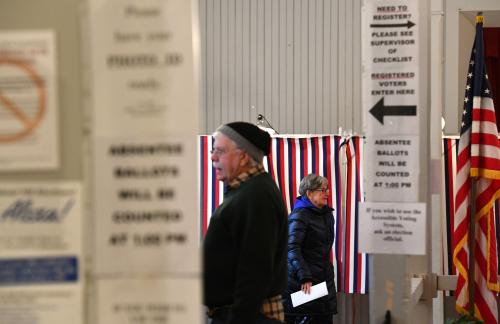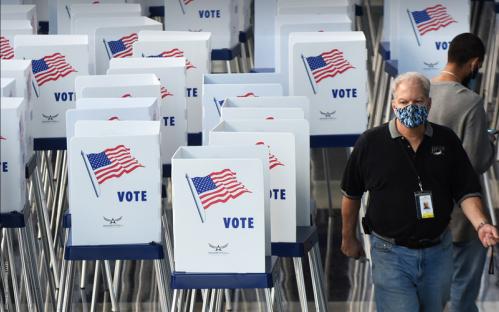The key to Donald Trump’s surprising 2016 victory was his outsized performance in nonurban parts of the electorate, especially whiter rural counties in the critical states of Michigan, Pennsylvania, and Wisconsin. In 2020’s race, Trump is again focusing his attention on this base—but voting patterns from the 2018 midterms and recent surveys indicate support for him in these places could be weaker than four years ago.
The 2018 midterms led to a “blue wave,” sending 40 additional Democrats to the House of Representatives. It also cut Republican voting margins in the vast majority of small metropolitan and rural counties, including those in northern battleground states. Furthermore, recent polls in those states display sharp shifts among white voters toward Democratic challenger Joe Biden, and away from Trump.
This analysis of U.S. counties—nationally and in Michigan, Pennsylvania, Wisconsin, and Iowa—shows how voting preferences outside of urban core counties have shifted since 2016, suggesting flagging support for the president in this election.
The 2018 midterms showed higher Democratic support in most small counties
To get a sense of how county-level voting preferences have shifted, Map 1 shows the change in Democratic minus Republican (D-R) voter margins that occurred between the 2016 presidential election and the 2018 midterm elections. (The D-R margin is defined as the percent voting Democratic minus percent voting Republican.) A change in the margin indicates whether Democratic support increased or decreased over the 2016 to 2018 period relative to Republican support, even if the same party was victorious in both elections.*

The vast majority of U.S. counties showed a rise in their D-R margin between the 2016 and 2018 elections. In fact, 83% of the country’s population resided in counties with rising D-R margins. These rises occurred in both very Democratic states such as those in New England, and in strong Republican states such as Nebraska and Oklahoma. In the former, Democratic support became stronger; in the latter, Republican support became weaker.
Especially important for the 2020 election is the trend toward weaker Republican support in the vast majority of suburban, small metropolitan and rural counties. Among the 3,013 such counties, 2,436 showed rises in the D-R margins between 2016 and 2018. Many of these voted Republican in both the 2016 and 2018 elections, but with weaker—sometimes much weaker—Republican support in 2018.
To see how this translates into aggregate votes nationally, Figure 1 and Table A (Download Table A) depict net Democratic or Republican vote advantages across different elections for urban categories of counties. When examining the votes for the 2016 and 2018 elections, the Republican vote advantage in small metropolitan areas and nonmetropolitan areas was reduced from 9.3 million to 5.2 million.

There was also a shift in large suburban counties, from a Republican advantage of 1.2 million votes in 2016 to a Democratic advantage of 2 million votes 2018. Overall, these suburban, small metropolitan, and nonmetropolitan shifts strongly contributed to the rise in the national Democratic popular vote advantage, from 2.8 million in 2016 to 9.5 million in 2018. If this trend continues for 2020, Trump’s small-county advantage might shrink considerably.
Figure 1 also depicts the net Democratic or Republican vote advantages for the 2008 and 2012 presidential elections won by Barack Obama. In each of these elections, the Republican vote in small metropolitan and nonmetropolitan counties was substantially smaller than in 2016. Clearly, the large contribution among voters in these counties in 2016 had much to do with Trump’s victory that year, underlying his need to secure their support again.
Northern swing states show potential declines in small-county Trump support
The importance of the northern swing states in deciding 2020’s election cannot be overstated. Interestingly, if one applied the 2018 midterm votes discussed above to states, four northern swing states would flip from a 2016 Republican win to Democratic win: Michigan, Pennsylvania, Wisconsin, and Iowa. (Arizona also shifts from a Republican vote advantage to a Democratic one.) (Download Table B)
Small metropolitan counties and nonmetropolitan counties were important for Trump’s narrow wins in these four states, which went for Obama in the two prior elections. But Figure 2 and Table A (Download Table A) show that 2016 appears to be an outlier compared with earlier presidential elections and the 2018 midterms in terms of stronger Republican vote totals in these smaller counties.

In Michigan, for example, 2016 is the only one of the four elections studied here in which the combined small metropolitan and nonmetropolitan counties favored Republicans. As a group, nonmetropolitan counties voted fairly consistently for Republicans in all four elections. Several small metropolitan area counties that previously voted Democratic (including those in the Flint and Saginaw metropolitan areas) voted Republican, or far less Democratic, in 2016. This was also the case for Macomb County in the Detroit suburbs. Wayne County—home of Detroit—showed a clear dip in its Democratic vote in 2016.
Many small counties in Michigan—even those that already voted consistently Republican in earlier elections—registered greater Republican margins in 2016, only to revert somewhat in 2018. Among all 73 small metropolitan and nonmetropolitan counties, 69 showed increased Republican (or reduced Democratic) margins between 2012 and 2016, while 70 voted less Republican (or more Democratic) in 2018. (Download Table C for individual Michigan county statistics)
Pennsylvania’s flip to Trump in 2016 can also be attributed to outsized Republican voting in the suburbs, small metropolitan areas, and nonmetropolitan areas—only to revert closer to earlier levels in the 2018 midterms. (Download Table D for individual Pennsylvania county statistics)
Among Pennsylvania’s 44 small and nonmetropolitan counties (largely in the central and western parts of the state), 43 showed Republican margin gains—often substantial ones—between the 2012 and 2016 elections. In 2018, all 44 moved in the opposite direction, toward Democrats.
Also important for Trump’s 2016 Pennsylvania win were flips to Republicans for some previously Democratic-leaning suburban counties in the northeastern part of the state (the Scranton/Wilkes-Barre region and the Lehigh Valley) and stronger Republican support in suburban Pittsburgh. However, like the smaller counties, most of these areas became either more Democratic or less Republican in 2018. In both elections, the Greater Philadelphia area voted strongly Democratic.
In Wisconsin, the scale of the Republican vote in the state’s small and metropolitan counties will determine whether it can counter the Democratic advantage in the party’s strongholds of Milwaukee and Madison. The former counties as well as small metro areas such as Green Bay and Eau Claire made a huge swing toward Republicans in 2016, helping Trump win the state. Yet as with the previous states discussed, there was some reversion to more Democratic and less Republican support in the 2018 midterms, including eight nonmetropolitan “Obama-Trump” counties which returned to voting Democratic. (Download Table E for individual Wisconsin county statistics)
Iowa’s vote swings before and after 2016 were more extreme than the previous three states. Twenty-eight of its 78 nonmetropolitan counties voted for Obama in 2012, while all of them voted for Trump in 2016. In 2018, they all voted less Republican, with 11 voting Democratic. Similar shifts back and forth occurred for most small metropolitan counties, with notable swings in the metro areas of Cedar Rapids, Sioux City, and Dubuque, as well as suburban Omaha. (Download Table F for individual Iowa county statistics)
As a largely nonmetropolitan state, Iowa’s results for this election will depend on the directions of the rural and small-town vote, which favored Republicans less in 2018 than when Trump won there in 2016.
The white vote for Trump is dropping
The above analysis makes plain why small metropolitan and nonmetropolitan voters mattered so greatly to Trump’s 2016 victory, and why their support for him in 2020 is questionable. Further evidence of a potential flip stems from recent polling on white voters, particularly the so-called “white noncollege” voters who were the center of Trump’s base in 2016.
As shown in Figure 3, white residents comprise large shares of the adult population in the small metropolitan and nonmetropolitan areas of the four states studied here, just below or greater than 90% in each. And in these areas, white noncollege residents make up roughly two-thirds of adults. Even these states’ suburbs are far “whiter” than those nationally—ranging from 80% to 92% white, compared with 69% for the country as a whole. (Statistics for individual counties in each state are shown in downloadable Tables C, D, E, and F.)


But support for Trump in these groups has faded recently compared to 2016. Figure 4 compares D-R voter margins between 2016 election exit polls and surveys undertaken by The New York Times and Siena College for 2020. In each of the four states, the Republican advantage among noncollege whites has fallen by half or more: from roughly 30 to 15 in Michigan and Pennsylvania, from 28 to 7 in Wisconsin, and from 20 to 8 in Iowa.
Among college-educated whites in Michigan, Pennsylvania, and Iowa, there are shifts from small Trump advantages in 2016 to wider Biden advantages in 2020. In Wisconsin, where white college graduates already favored the Democrat, Hillary Clinton, in 2016 by 12 points, their margin for Biden rises to 28 points with the recent polls.
A rural- and suburban-powered win for Biden?
The trends revealed here point toward an electoral pivot in rural and small towns since 2016—if not to full-throated Biden support, then certainly to weaker Trump support. While the 2018 midterm elections may not be a completely accurate predicator of county-level support for the president on Election Day 2020, it does indicate weaker Republican support among many small metropolitan and nonmetropolitan counties than what existed in 2016. Declining support for Trump among noncollege whites in recent polls would seem to reinforce this trend.
Of course, as in 2016, Election Day can always bring surprises. But in these four swing states where rural and suburban voters were so key to Trump’s 2016 victory, there is reason to predict a rural- and suburban-powered win for Biden.
*A change in D-R support does not necessarily mean a change from Democratic to Republican or Republican to Democratic election outcome. For example, a county that that voted Republican (for Trump) in 2016 with a D-R margin of -10 and voted for a Republican House of Representatives candidate in 2018 with a D-R margin of -5 would show a change in D-R margin of +5—a shift toward stronger Democratic support and weaker Republican support.







